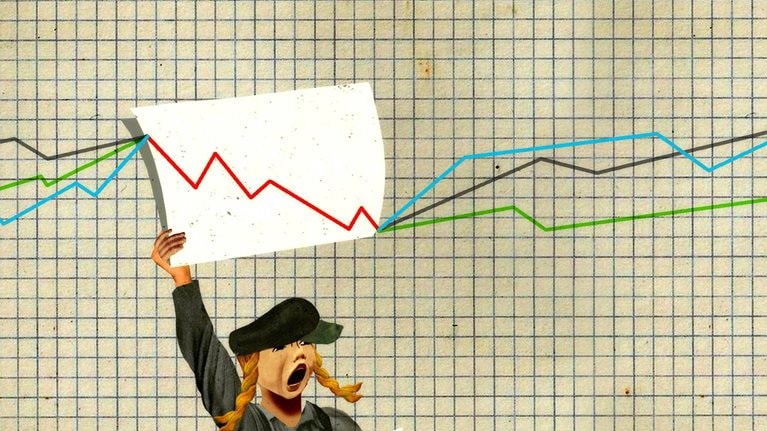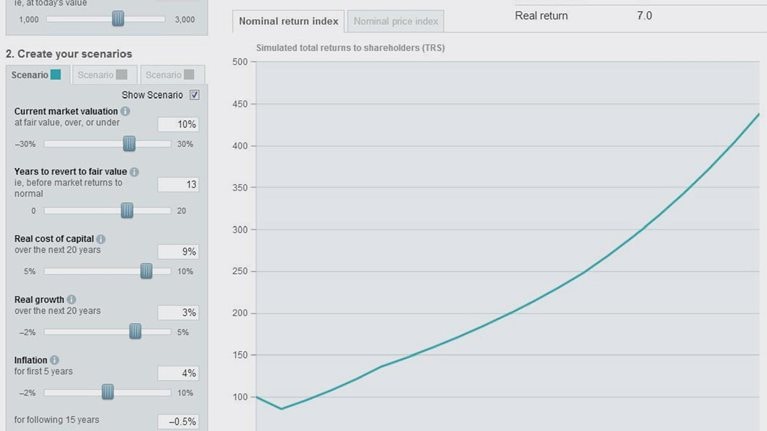For much of this year, the S&P 500 index has demonstrated fitful but steady growth, lifting it from just over 1,800 in January to just over 2,000 in September—a new record. That’s something of a disconnect with lackluster economic growth and rising interest rates, and it has investors puzzled and executives casting a gimlet eye on their share prices.
Whether you think the market is dangerously overvalued, as some worry, or that current high corporate profits and multiples are the result of fundamental changes in the performance of companies depends on your expectations of profit growth, cost of capital, and returns on capital.1 In fact, much of the market’s value today is clearly tied to underlying sources of economic performance—and, in particular, the high level of profit margins in several high-performing sectors.
What’s behind the lofty P/E ratio?
At the highest level, the total market capitalization of companies in the S&P 500 index is $18.5 trillion. Their projected 2014 earnings of $1.1 trillion to $1.2 trillion imply a price-to-earnings ratio (P/E) of about 16 to 17—values that are well above average. We analyzed both multiples and earnings to understand what’s supporting their levels.
One explanation we often hear for the market’s current level—a lower cost of equity—doesn’t hold up to scrutiny. In fact, much of the increase in share prices has come over the past two years, a period in which long-term government-bond rates have actually increased. That development alone should quiet any assumptions that investors are discounting future cash flows at a lower cost of equity as a result of low interest rates, but earlier McKinsey research discounted that possibility even when government-bond rates declined following the financial crisis.2 Moreover, the cost of equity has been remarkably stable (in real terms) over the past 50 years.
So what is boosting share prices relative to earnings? P/Es are normally underpinned by expected earnings growth, expected returns on capital, and the cost of capital. But in the past several years, P/Es have also been affected by the high proportion of cash that US companies are holding. In fact, that cash buildup and an increase in returns on capital are together responsible for boosting the median P/E for the S&P 500 by about 2 points, from an average of 14 to 15 during the 1965 to 2012 period (excluding the high inflationary period of the 1970s).
Half of that increase can be attributed to higher returns. Returns on capital affect P/E because they influence a company’s cash flow. Higher returns at a constant rate of growth and cost of capital lead to a higher P/E because a company doesn’t need to reinvest as much to continue growing.3 The aggregate returns on capital for the S&P 500 have increased to about 17 percent from about 12 percent over the past two decades. That increase explains about one point of the observed increase in the index’s P/E.
The other half of the increase can be attributed to the extraordinary amount of cash today’s large US-based companies are holding on their balance sheets (mostly outside the United States to avoid taxes on its repatriation). We conservatively estimate that nonfinancial US companies have at least $1.3 trillion of excess cash that is mostly invested in shorter-term government securities earning less than 1 percent, before taxes. With such a low denominator for the ratio, the effective P/E on the cash is very high. For example, if the cash earns 0.7 percent per year after tax, its price would be about 140 times its earnings. The impact of all this cash is to increase the measured P/E by another point. In other words, if companies weren’t holding all this cash, their market capitalization would be lower by about $1.3 trillion—and their earnings would be roughly the same.
What about margins?
The key to understanding the current record-high value of the S&P 500 is not the P/E multiple but the high level of profit margins—and that, too, requires some examination. Major shifts in the composition of the S&P 500 since the mid-1990s have led to a higher aggregate profit margin for the index. Aggregate pretax profits were stable at around 10 percent of revenues from 1970 to 1995. But since then, profit growth in the financial, IT, and pharmaceuticals and medical-products sectors has outpaced other sectors, and their margins have increased, substantially increasing their share of total corporate profits (Exhibit 1). As a result, aggregate pretax profits grew to 14 percent of revenues in 2013 and are expected to hit 15 percent in 2014.
Three sectors have grown to dominate S&P 500 index profits.

The profits of financial institutions alone increased from 4 percent of the index’s total profits in 1990 to 16 percent in 2013. This was largely due to so-called financial deepening, as financial assets have grown faster than GDP.4 Bank assets and tangible equity increased by 15 percent and 13 percent per year, respectively, relative to nominal GDP growth of 5 percent per year.
Not surprisingly, profits in the IT sector also increased substantially relative to the rest of the economy over the same time period, climbing to 18 percent of total profits from 7 percent. Coincidentally, the sector’s aggregate profit margin also increased to 18 percent from 7 percent (Exhibit 2). The increase in margins is largely driven by the fact that higher-margin software companies now command roughly 70 to 80 percent of the sector’s profits.
Aggregate profit margins increased for the same three sectors.

The healthcare-products sector increased its share of profits to 10 percent from 6 percent, again between 1990 and 2013, both due to faster growth and an increase in profit margins, which rose to 24 percent from 13 percent. The increase in profit margins in pharmaceuticals is largely due to the development of new drugs with higher margins than earlier drugs.
What’s the prognosis?
Assessing the market’s current value ultimately depends on whether the profit margins are sustainable. While we can’t predict the future, we can show what the fundamental value of the S&P 500 should be based on different profit-margin scenarios. Under the first, assuming current levels of profit margins are sustainable, the fundamental value of the S&P 500 would be in the range of 1,900 to 2,100. Under a second, assuming profit margins will return to 1990 levels, the fundamental value of the index would be 1,400 to 1,600. Under a hypothetical third scenario in the middle, the aggregate profit margin would be roughly at par with the 2003 to 2005 average, a period before the Great Recession, and the fundamental value of the index would be around 1,600 to 1,800.
A strong case can be made that aggregate profit margins will not revert to 1990 levels. The composition of large US companies has shifted from traditional manufacturing to intellectual property–based companies with inherently higher margins and returns on capital, such as software, pharmaceuticals, and medical devices. In addition, these US-based companies derive a substantial share of their profits from outside the United States, which should allow them to sustain their size relative to other S&P 500 companies.
It’s less clear whether the current level of margins is sustainable. In the IT sector, for example, many of the current top companies (including Cisco, Google, Microsoft, Oracle, and Qualcomm) didn’t exist or were small in 1990—relative to both the size they are today and the size of the dominant companies in the market at that time. Given the dynamism of the sector, it’s impossible to say whether a next generation of competitors will take away some of the high profits of today’s top performers. Similarly, in pharmaceuticals and medical devices, today’s high margins are supported by blockbuster drugs that have been losing patent protection, opening the door to competition from generics. The sector’s R&D productivity has been declining over the past 20 years, and the next generation of drugs may have lower revenues and margins per drug as they are targeting smaller patient markets. Furthermore, US government steps to reduce healthcare costs could also affect margins in these industries.
The current state of the financial sector is a conundrum. Despite increased regulation, the past four quarters combined have generated profits that are among the sector’s highest ever, on an annualized basis. In this era of ultralow interest rates, US banks have been earning near-record-high spreads between the rates at which they lend and the rates they pay on deposits and debt.5 It’s possible those spreads will decline to lower levels if interest rates increase to historical levels. Additionally, some sectors, such as transportation and manufacturing, are cyclical and at high points in their cycles.
Another, less tangible factor across all sectors is that companies may be underinvesting. For example, our recent survey found that a substantial number of executives believe their companies are passing up value-creating investment opportunities, especially in new-product and market development. If that continues, the current focus of many companies on cost cutting and short-term profits may well affect the sustainability of the market’s valuation.


